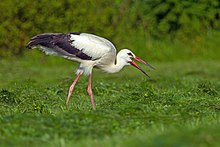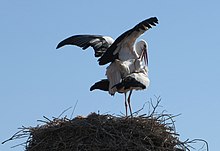വെൺബകം
| വെൺബകം | |
|---|---|
| ശാസ്ത്രീയ വർഗ്ഗീകരണം | |
| കിങ്ഡം: | |
| Phylum: | |
| Class: | |
| Order: | |
| Family: | |
| Genus: | |
| Species: | C. ciconia
|
| Binomial name | |
| Ciconia ciconia (Linnaeus, 1758)
| |

| |
| Approximate ranges and routes
Breeding range Migration routes
| |
| Synonyms | |
|
Ardea ciconia Linnaeus, 1758 | |
വെൺ ബകത്തിന്റെ ഇംഗ്ലീഷ് പേര് White stork എന്നും ശാസ്ത്രീയ നാമം Ciconia ciconia എന്നുമാണ്.
രൂപ വിവരണം
[തിരുത്തുക]ദീർഘ ദൂര ദേശാടകരാണ്. തെക്കെ ആഫ്രിക്കയിലേക്കും ഇന്ത്യൻ ഉപഭൂഖണ്ഡത്തിലേക്കും ദേശാടനം നടത്തുന്നു. യൂറോപ്പിൽ നിന്ന് ആഫ്രിക്കയിലേക്ക് ദേശാടനം നടത്തുമ്പോൾ അനുകൂല വായു പ്രവാഹം ഇല്ലാത്തതിനാൽ മെഡിറ്ററേനിയൻ കടൽ കടക്കാറില്ല
ഭക്ഷണം
[തിരുത്തുക]മത്സ്യം, ചെറിയ സസ്തനികൾ, പ്രാണികൾ,ഇഴജന്തുക്കൾ എന്നിവയെ ഭക്ഷിക്കുന്നു. ആഴം കുറഞ്ഞ വെള്ളമുള്ളിടത്തും, അധികം ചെടികളില്ലാത്തിടത്തും നിലത്തുനിന്ന് ഇര തേടുന്നു. ഏക പസ്ത്നീവൃതക്കാരാണ്. ഇണകൾ ചേർന്ന് ഉണ്ടാക്കുന്ന കൂട് വർഷങ്ങളോളം ഉപയോഗിക്കുന്നു. ഒരു തവണ(Clutch) 4 മുട്ടകൾ ഇടുന്നു. ഇവ 33-34 ദിവസംകൊണ്ട് വിരിയുന്നു. പൂവനും പിടയും അടയിരിക്കുകയും കുഞ്ഞുങ്ങളെ തീറ്റുകയും ചെയ്യുന്നു. കുഞ്ഞ്`58-64 ഡദിവസത്തിനകം കൂട് ഉപേക്ഷിക്കുന്നു. പിന്നീട് 7-20 ദിവസം വരെ രക്ഷിതാക്കൾ തീറ്റ കൊടുക്കുന്നു.
രൂപ വിവരണം
[തിരുത്തുക]
മുഴുവൻ വെളുത്ത നിറം. ചിറകിൽ കറുത്ത നിറം. .[2] നീണ്ട ചുവന്ന കാലുകൾ, നീണ്ട ചുവന്ന ചുണ്ട്. ,[3] വലിയ പക്ഷിയാണ്. നീളം 100-115 സെ.മീ. ആണ്. [nb 1][4] ഉയരം 100-125 സെ.മീ. ആണ്, ചിറകു വിരിപ്പ് 155-215 സെ.മീ ആണ്. തൂക്കം 2.3 -4.5 കി.ഗ്രാം ആണ്.[5][6] നീണ്ട കാലും നീണ്ട കഴുത്തും വളവില്ലാത്ത കൂർത്ത കൊക്കും ഉണ്ട്.]]. [7] പൂവനും പിടയും കാഴ്ചയ്ക്ക് ഒരേപോലെയാണ്. പൂവന് വലിപ്പം കൂടും..[3] മാറിടത്തിൽ നീണ്ടാ തൂവലുകൾ ഉണ്ട്.[8] കണ്ണിനു മങ്ങിയ തവിട്ടു നിറം, കുറ്റുമുള്ള ത്വക്കിനു കറുപ്പും. കൊക്കിനും കാലിനുമുള്ള ചുവപ്പു നിറം ഭക്ഷണത്തിൽ നിന്നു കിട്ടുന്ന ചായം കൊണ്ട് ഉണ്ടായതാൺർന്ന് സ്പെയിനിൽ നടത്തിയ പഠനൻ തെളിയിക്കുന്നു.[9]

വീതിയും നീളവും കൂടിയ ചിറകുകൾ ഉയ്യരത്തിൽ പറക്കാൻ സഹായിക്കുന്നു. [10] പറക്കുമ്പോൾ കഴുത്ത് നീട്ടിപിടിച്ചിരിക്കും, കാലുകൾ ചറകിനു പുറത്തേക്ക് നീണ്ടിരിക്കും. പതുക്കെ, നിവർന്നാണ് നടക്കുന്നത് . sfn|Cramp|1977|p=328}} തൂവൽ പൊഴിക്കുന്നവയാണ്.[8]

പ്രജനനം
[തിരുത്തുക]
ഒരേകൂടു തന്നെ വർഷങ്ങളോളം ഉപയോഗിക്കും. ആദ്യം തിരിച്ചെത്തുന്നവർ കൂടൂകൾ തിരഞ്ഞെടുക്കും.[11]

മറ്റു പല പക്ഷികളും ഇവയ്യുടെ വലിയ കൂടിനെ കൂടായി ഉപയൊഗിക്കാറുണ്ട്. അങ്ങാടി കുരുവി ഇതിൽ ഒന്നാണ്..[12][13]
കൊല്ലത്തിൽ ഒരു സ്ഥലത്തു മാത്രമെ മുട്ടയിടാറുള്ളു. 1-7 മുട്ടകളിടും. അഴുക്കുപിടിച്ചപോലുള്ള വെള്ള മുട്ടകളാണ് ഇടുന്നത്.< ref name="Oologia neerlandica" /> [14] ആദ്യ മുട്ട ഇടുമ്പോൾ തന്നെ അടായിരിക്കാൻ തുടങ്ങുന്നു. 33-34 ദിവസംകൊണ്ട് മുട്ട വിരിയുന്നു. [15][16]

ചെറിയ കുഞ്ഞുങ്ങൾക്ക് ഭക്ഷണം കൂടിന്റെ തറയിൽ ഛർദ്ദിച്ചു കൊടുക്കുകയാണ് ചെയ്യുന്നത്. എന്നാൽ കുറച്ചുകൂടി പ്രായമായവ രക്ഷിതാക്കളുടെ വായിൽ നിന്ന് ഭക്ഷണം എടുക്കുന്നു. നാലു വയസ്സാവുമ്പോഴാണ് പ്രജനനം നടത്തുന്നത്.[8] 39 വയസ്സുള്ളവയെ സ്വിറ്റ്സർലന്റിൽ രേഖപ്പെടുതിയിടുണ്ട്.[17]
വിതരണം
[തിരുത്തുക]
യൂറോപ്പ് മുഴുവനും വടക്കെഅമേരിക്കയിലും കാണുന്നു. ലോകത്തുള്ളവയിൽ 25% പോളണ്ടിൽ കാണുന്നു.[18] ഇവ തുറന്ന പുൽമൈതാനങ്ങളിൽ ഈർപ്പമുള്ളിടത്തൊ ഇട്യ്ക്ക് വെള്ളപ്പൊക്കം ഉള്ളിടത്തൊ കൂട്ടമായി പ്രജനനം നടത്തുന്നു. ഉയർന്ന പുല്ലുകൾ ഉള്ളിടത്തൊ മരങ്ങൾക്ക് താഴെയോ കൂട് കെട്ടാറില്ല.[19]
വെൺബകം പായലുകൾ കൊക്കിലെടുത്ത് പിഴിഞ്ഞ് കുട്ടികൾക്ക് വെള്ളം ഇറ്റിറ്റായി കൊടുക്കാറുണ്ട്.[20] മുകളിലും താഴെയുമുള്ള കൊക്കുകൾ കൂടി മുട്ടിച്ച് ഉണ്ടാക്കുന്ന ശബ്ദം കഴുത്തിലെ സഞ്ചി ഉച്ചത്തിലാക്കുന്നു.
കൊതുകുകളാണ് പക്ഷികൾക്കിടയിൽ രോഗം പരത്തുന്നത്.[21]
ഭക്ഷണം
[തിരുത്തുക]ഇവ ഒരു പാടുടുതരം ജീവികളെ ഭക്ഷിക്കുന്നു. കൂടിനു 5 കി.മീ. ചുറ്റളവിൽ ഇര തേടാറുണ്ട്.ഇര്യെ പെട്ടെന്നു കാണുന്നതിനു വേണ്ടി അധികം ഉയരമില്ലാത്ത പുല്ലുകൾക്കിടയിലാണ് ഇര തേടുന്നത്. പ്രാണികൾ, പുൽച്ചാആടികൾ , മണ്ണിര, തവളകൾ, മത്യം, ഞണ്ട്, ഞവിഞ്ഞി, ഉരഗങ്ങൾ എന്നി വ ഭക്ഷിക്കുന്നു. അപൂർവ മായി പക്ഷി മുട്ടകളും പക്ഷി കുഞ്ഞുങ്ങളേയും ഭക്ഷിക്കുന്നു. ഇര കളെ മുഴുവനായി വിഴുങ്ങുകയ്യാണ് ചെയ്യുന്നത്. വലിയ ജീവികളെ കൊക്കുകൊണ്ട് കൊന്ന ശേഷം വിഴുങ്ങുന്നു. മണ്ണിരയെന്നു കരുതി റബ്ബർ ബാൻഡ് കഴിച്ച് പ്രശ്നത്തിലാവാറുണ്ട്.[22]

അവലംബം
[തിരുത്തുക]- Cramp, Stanley, ed. (1977). Handbook of the Birds of Europe, the Middle East and North Africa, the Birds of the Western Palearctic. Vol. Vol. 1: Ostrich to Ducks. Oxford University Press. ISBN 0-19-857358-8.
{{cite book}}:|volume=has extra text (help)CS1 maint: ref duplicates default (link) - Elliott, Andrew (1992). "Family Ciconiidae (Storks)". In del Hoyo, Josep; Elliott, Andrew; Sargatal, Jordi (eds.). Handbook of the Birds of the World. Vol. Vol. 1: Ostrich to Ducks. Barcelona: Lynx Edicions. ISBN 84-87334-10-5.
{{cite book}}:|volume=has extra text (help)CS1 maint: ref duplicates default (link) - Newton, Ian (2010). Bird Migration. Collins New Naturalist Library. Vol. 113. London: Collins. ISBN 0-00-730732-2.
{{cite book}}: CS1 maint: ref duplicates default (link) - Svensson, Lars; Grant, Peter J. (1999). Collins Bird Guide. London: HarperCollins. ISBN 0-00-219728-6.
- Van den Bossche, Willem (2002). Eastern European White Stork Populations: Migration Studies and Elaboration of Conservation Measures (PDF). (In collaboration with: Berthold, Peter; Kaatz, Michael; Nowak, Eugeniusz; Querner, Ulrich). Bonn: Bundesamt für Naturschutz (BfN)/German Federal Agency for Nature Conservation. Archived from the original (PDF) on 2011-07-18. Retrieved 2015-09-28.
{{cite book}}: CS1 maint: ref duplicates default (link)
- ↑ "Ciconia ciconia". IUCN Red List of Threatened Species. Version 2013.2. International Union for Conservation of Nature. 2012. Retrieved 26 November 2013.
{{cite web}}: Cite has empty unknown parameter:|last-author-amp=(help); Invalid|ref=harv(help); Unknown parameter|authors=ignored (help) - ↑ Grande, Juan Manuel; Negro, Juan José; María Torres, José (2004). "The evolution of bird plumage colouration; A role for feather-degrading bacteria?" (PDF). Ardeola. 51 (2): 375–83. doi:10.1007/s00114-008-0462-0.
- ↑ 3.0 3.1 Elliott 1992, pp. 460–1.
- ↑ Cramp 1977, p. 3.
- ↑ Mead, C.; Ogilvie, M. (2007). The Atlas of Bird Migrations: Tracing the Great Journeys of the World's Birds. Cape Town: Struik. pp. 88–89. ISBN 978-1-77007-499-6.
- ↑ Hancock, James; Kushan, James A. (1992). "White stork". Storks, Ibises and Spoonbills of the World. Princeton University Press. ISBN 978-0-12-322730-0.
- ↑ Elliott 1992, p. 437.
- ↑ 8.0 8.1 8.2 Cramp 1977, p. 335.
- ↑ Negro, Juan José; Garrido-Fernandez, Juan (2000). "Astaxanthin is the major carotenoid in tissues of White Storks (Ciconia ciconia) feeding on introduced Crayfish (Procambarus clarkii)". Comparative Biochemistry and Physiology Part B. 126 (3): 347–52. doi:10.1016/S0305-0491(00)00180-2. PMID 11007176.
- ↑ Elliott 1992, p. 438.
- ↑ Vergara, Pablo; Gordo, O.; Aguirre, José I. (2010). "Nest size, nest building behaviour and breeding success in a species with nest reuse: The White Stork Ciconia ciconia" (PDF). Annales Zoologici Fennici. 47 (3): 184–94. doi:10.5735/086.047.0303.
- ↑ Haverschmidt, François (1949). The Life of the White Stork. Leiden: E. J. Brill. pp. 33-4. OCLC 1576336 – via Google Books.
{{cite book}}: CS1 maint: ref duplicates default (link) - ↑ Tortosa, Francisco S.; Redondo, Tomas (1992). "Frequent copulations despite low sperm competition in White Storks (Ciconia ciconia)". Behaviour. 121 (3&4): 288–315. doi:10.1163/156853992X00408. JSTOR 4535031.
- ↑ van Pelt Lechner, A. A. (1911). Oologia Neerlandica : Eggs of Birds Breeding in the Netherlands. Vol. Vol. II. The Hague, Netherlands: Nijhof. p. 118 – via The Internet Archive.
{{cite book}}:|volume=has extra text (help) - ↑ Zielinski, Piotr (2002). "Brood reduction and parental infanticide – are the White Stork Ciconia ciconia and the Black Stork C. nigra exceptional?" (PDF). Acta Ornithologica. 37 (2): 113–9. doi:10.3161/068.037.0207. Archived from the original (PDF) on 2012-03-15. Retrieved 2015-09-28 – via University of Łódź.
- ↑ Tortosa, Francisco S.; Redondo, Tomas (1992). "Motives for parental infanticide in White Storks Ciconia ciconia". Ornis Scandinavica. 23 (2): 185–9. doi:10.2307/3676447. JSTOR 3676447.
- ↑ "EURING list of longevity records for European birds". EURING. 2010. Retrieved 2 December 2010.
- ↑ Chernetsov, Nikita; Chromik, Wiesław; Dolata, Pawel T.; Profus, Piotr; Tryjanowski, Piotr (2006). "Sex-related natal dispersal of White Storks (Ciconia ciconia) in Poland: How far and where to?" (PDF). The Auk. 123 (4): 1103–9. doi:10.1642/0004-8038(2006)123[1103:SNDOWS]2.0.CO;2 – via The Russian Academy of Sciences: Zoological Institute: Biological Station Rybachy.
{{cite journal}}: External link in|via=|displayauthors=ignored (|display-authors=suggested) (help) - ↑ Carrascal, Luis María; Bautista, Luis Miguel; Lázaro, Encarnación (1993). "Geographical variation in the density of the White Stork Ciconia ciconia in Spain: Influence of habitat structure and climate". Biological Conservation. 65 (1): 83–7. doi:10.1016/0006-3207(93)90200-K.
- ↑ Lefebvre, Louis; Nicolakakis, Nektaria; Boire, Dennis (2002). "Tools and brains in birds" (PDF). Behaviour. 139 (7): 939–73. doi:10.1163/156853902320387918 – via McGill University.
- ↑ Hayes, Edward B.; Komar, Nicholas; Nasci, Roger S.; Montgomery, Susan P.; O'Leary, Daniel R.; Campbell, Grant L. (2005). "Epidemiology and transmission dynamics of West Nile Virus Disease". Emerging Infectious Diseases. 11 (8): 1167–73. doi:10.3201/eid1108.050289a. PMC 3320478. PMID 16102302.
{{cite journal}}: Unknown parameter|displayauthors=ignored (|display-authors=suggested) (help) - ↑ Henry, PY; Wey, GR; Balança, G (2011). "Rubber band ingestion by a rubbish dump dweller, the White Stork (Ciconia ciconia)". Waterbirds. 34 (4): 504–8. doi:10.1675/063.034.0414.
പുറത്തേയ്ക്കുള്ള കണ്ണികൾ
[തിരുത്തുക]- Audio recordings of White stork on Xeno-canto.
- Ageing and sexing by Javier Blasco-Zumeta & Gerd-Michael HeinzePDF (4.43 MB)
- European white stork videos, photos, and sounds at the Internet Bird Collection
- White stork photo gallery at VIREO (Drexel University)
- ↑ നീളം അളക്കുന്നത് കൊക്കിന്റെ ഹുമ്പു മുതൽ വാലിന്റെ അറ്റം വരെയാണ്.

